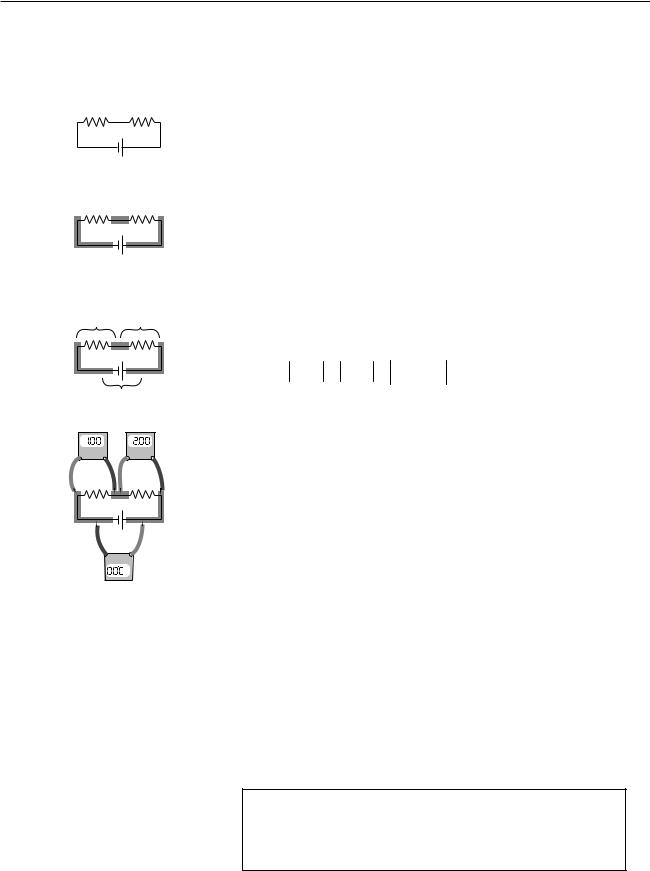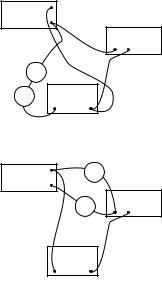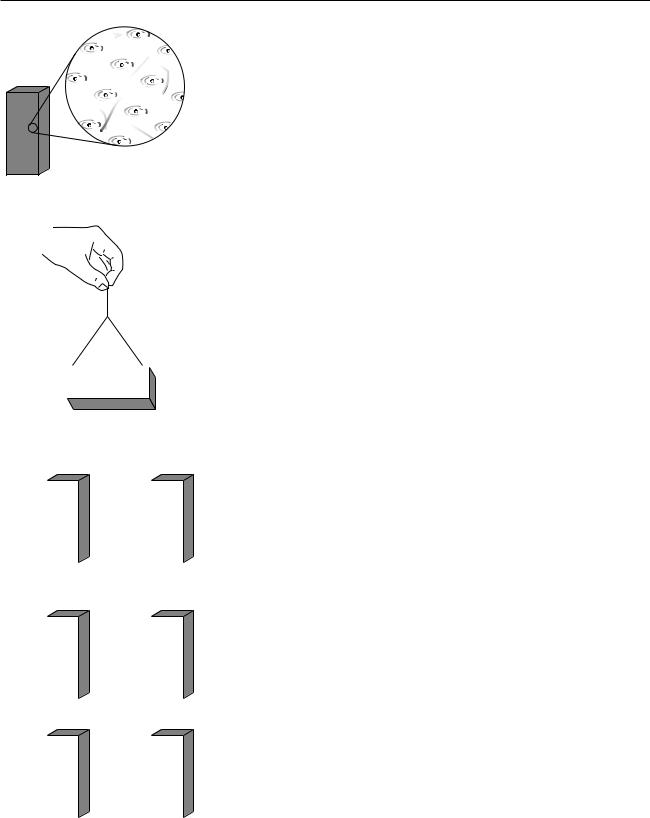
B.Crowell - Electricity and Magnetism, Vol
.4.pdf
4.3Series Resistances
(a)R1 R2
Vbattery
(b)R1 R2
Vbattery
V1 V2
(c)
Vbattery
(d)
The two basic circuit layouts are parallel and series, so a pair of resistors in series, (a), is another of the most basic circuits we can make. By conservation of charge, all the current that flows through one resistor must also flow through the other (as well as through the battery):
I1 = I2 .
The only way the information about the two resistance values is going to be useful is if we can apply Ohm’s law, which will relate the resistance of each resistor to the current flowing through it and the voltage difference across it. Figure (b) shows the three constant-voltage areas. Voltage differences are more physically significant than voltages, so we define symbols for the voltage differences across the two resistors in figure (c).
We have three constant-voltage areas, with symbols for the difference in voltage between every possible pair of them. These three voltage differences must be related to each other. It is as though I tell you that Fred is a foot taller than Ginger, Ginger is a foot taller than Sally, and Fred is two feet taller than Sally. The information is redundant, and you really only needed two of the three pieces of data to infer the third. In the case of our voltage differences, we have
V 1 + V 2 = V battery .
The absolute value signs are because of the ambiguity in how we define our voltage differences. If we reversed the two probes of the voltmeter, we would get a result with the opposite sign. Digital voltmeters will actually provide a minus sign on the screen if the wire connected to the “V” plug is lower in voltage than the one connected to the “COM” plug. Analog voltmeters pin the needle against a peg if you try to use them to measure negative voltages, so you have to fiddle to get the leads connected the right way, and then supply any necessary minus sign yourself.
Figure (d) shows a standard way of taking care of the ambiguity in signs. For each of the three voltage measurements around the loop, we keep the same probe (the darker one) on the clockwise side. It is as though the voltmeter was sidling around the circuit like a crab, without ever “crossing its legs.” With this convention, the relationship among the voltage drops becomes
V 1 + V 2 = – V battery ,
or, in more symmetrical form,
V 1 + V 2 + V battery = 0
More generally, this is known as the loop rule for analyzing circuits:
the loop rule
Assuming the standard convention for plus and minus signs, the sum of the voltage drops around any closed loop in a circuit must be zero.
Section 4.3 Series Resistances |
101 |

Doubling the length of a resistor is like putting two resistors in series. The resistance is doubled.
Looking for an exception to the loop rule would be like asking for a hike that would be downhill all the way and that would come back to its starting point!
For the circuit we set out to analyze, the equation
V 1 + V 2 + V battery = 0
can now be rewritten by applying Ohm’s law to each resistor:
I 1R 1 + I 2R 2 + V battery = 0 .
The currents are the same, so we can factor them out:
I R 1 + R 2
R 1 + R 2 + V battery = 0 ,
+ V battery = 0 ,
and this is the same result we would have gotten if we had been analyzing a one-resistor circuit with resistance R1+R2. Thus the equivalent resistance of resistors in series equals the sum of their resistances.
Example: two lightbulbs in series
Question: If two identical lightbulbs are placed in series, how do their brightnesses compare with the brightness of a single bulb? Solution: Taken as a whole, the pair of bulbs act like a doubled resistance, so they will draw half as much current from the wall. Each bulb will be dimmer than a single bulb would have been.
The total power dissipated by the circuit is I V. The voltage drop across the whole circuit is the same as before, but the current is halved, so the two-bulb circuit draws half as much total power as the one-bulb circuit. Each bulb draws one-quarter of the normal power.
Roughly speaking, we might expect this to result in one quarter the light being produced by each bulb, but in reality lightbulbs waste quite a high percentage of their power in the form of heat and wavelengths of light that are not visible (infrared and ultraviolet). Less light will be produced, but it’s hard to predict exactly how much less, since the efficiency of the bulbs will be changed by operating them under different conditions.
Example: more than two equal resistances in series
By straightforward application of the divide-and-conquer technique discussed in the previous section, we find that the equivalent resistance of N identical resistances R in series will beNR.
Example: dependence of resistance on length
In the previous section, we proved that resistance is inversely proportional to cross-sectional area. By equivalent reason about resistances in series, we find that resistance is proportional to length. Analogously, it is harder to blow through a long straw than through a short one.
Putting the two arguments together, we find that the resistance of an object with straight, parallel sides is given by
R = (constant) . L/A
The proportionality constant is called the resistivity, and it depends only on the substance of which the object is made. A resistivity measurement could be used, for instance, to help identify a sample of an unknown substance.
102 |
Chapter 4 Circuits, Part 2 |
Example: choice of high voltage for power lines
Thomas Edison got involved in a famous technological controversy over the voltage difference that should be used for electrical power lines. At this time, the public was unfamiliar with electricity, and easily scared by it. The president of the United States, for instance, refused to have electrical lighting in the White House when it first became commercially available because he considered it unsafe, preferring the known fire hazard of oil lamps to the mysterious dangers of electricity. Mainly as a way to overcome public fear, Edison believed that power should be transmitted using small voltages, and he publicized his opinion by giving demonstrations at which a dog was lured into position to be killed by a large voltage difference between two sheets of metal on the ground. (Edison’s opponents also advocated alternating current rather than direct current, and AC is more dangerous than DC as well. As we will discuss later, AC can be easily stepped up and down to the desired voltage level using a device called a transformer.)
Now if we want to deliver a certain amount of power PL to a load such as an electric lightbulb, we are constrained only by the equation PL=I VL. We can deliver any amount of power we wish, even with a low voltage, if we are willing to use large currents. Modern electrical distribution networks, however, use dangerously high voltage differences of tens of thousands of volts. Why did Edison lose the debate?
It boils down to money. The electric company must deliver the amount of power PL desired by the customer through a transmission line whose resistance RT is fixed by economics and geography. The same current flows through both the load and the transmission line, dissipating power usefully in the former and wastefully in the latter. The efficiency of the system is
efficiency |
= |
power paid for by the customer |
|||
power paid for by the utility |
|||||
|
|
||||
|
= |
PL |
|
||
|
PL + PT |
||||
|
|
||||
|
= |
1 |
|
|
|
|
1 + PT /PL |
||||
|
|
||||
Putting ourselves in the shoes of the electric company, we wish to get rid of the variable PT, since it is something we control only
indirectly by our choice of |
VT and I. Substituting PT=I VT, we find |
|||||
efficiency |
= |
|
1 |
|
|
|
|
|
I VT |
||||
|
1 + |
|
||||
|
|
PL |
|
|
||
We assume the transmission line (but not necessarily the load) is
ohmic, so substituting V T |
=IR gives |
|||||
|
|
|
|
T |
||
efficiency |
= |
|
1 |
|
|
|
|
|
I 2RT |
||||
|
1 + |
|
||||
|
|
PL |
|
|
||
This quantity can clearly be maximized by making I as small as possible, since we will then be dividing by the smallest possible quantity on the bottom of the fraction. A low-current circuit can only deliver significant amounts of power if it uses high voltages, which is why electrical transmission systems use dangerous high voltages.
Section 4.3 Series Resistances |
103 |

Example: getting killed by your ammeter
As with a voltmeter, an ammeter can give erroneous readings if it is used in such a way that it changes the behavior of the circuit. An ammeter is used in series, so if it is used to measure the current through a resistor, the resistor’s value will effectively be changed to R+Ra, where Ra is the resistance of the ammeter. Ammeters are designed with very low resistances in order to make it unlikely that R+Ra will be significantly different from R.
In fact, the real hazard is death, not a wrong reading! Virtually the only circuits whose resistances are significantly less than that of an ammeter are those designed to carry huge currents. An ammeter inserted in such a circuit can easily melt. When I was working at a laboratory funded by the Department of Energy, we got periodic bulletins from the DOE safety office about serious accidents at other sites, and they held a certain ghoulish fascination. One of these was about a DOE worker who was completely incinerated by the explosion created when he inserted an ordinary Radio Shack ammeter into a high-current circuit. Later estimates showed that the heat was probably so intense that the explosion was a ball of plasma — a gas so hot that its atoms have been ionized.
Discussion Question
We have stated the loop rule in a symmetric form where a series of voltage drops adds up to zero. To do this, we had to define a standard way of connecting the voltmeter to the circuit so that the plus and minus signs would come out right. Suppose we wish to restate the junction rule in a similar symmetric way, so that instead of equating the current coming in to the current going out, it simply states that a certain sum of currents at a junction adds up to zero. What standard way of inserting the ammeter would we have to use to make this work?
104 |
Chapter 4 Circuits, Part 2 |

Summary
Notation and Terminolog Used in Other Books
eV ..................................... |
a unit of energy, equal to e multiplied by 1 volt; 1.6x10 –19 joules |
Summary
A schematic is a drawing of a circuit that standardizes and stylizes its features to make it easier to understand. Any circuit can be broken down into smaller parts. For instance, one big circuit may be understood as two small circuits in series, another as three circuits in parallel. When circuit elements are combined in parallel and in series, we have two basic rules to guide us in understanding how the parts function as a whole:
the junction rule: In any circuit that is not storing or releasing charge, conservation of charge implies that the total current flowing out of any junction must be the same as the total flowing in.
the loop rule: Assuming the standard convention for plus and minus signs, the sum of the voltage drops around any closed loop in a circuit must be zero.
The simplest application of these rules is to pairs of resistors combined in series or parallel. In such cases, the pair of resistors acts just like a single unit with a certain resistance value, called their equivalent resistance. Resistances in series add to produce a larger equivalent resistance,
Rseries = R1 + R2 ,
because the current has to fight its way through both resistances. Parallel resistors combine to produce an equivalent resistance that is smaller than either individual resistance,
Rparallel = |
1 |
+ |
1 |
– 1 |
, |
R1 |
|
||||
|
|
R2 |
|
||
because the current has two different paths open to it.
An important example of resistances in parallel and series is the use of voltmeters and ammeters in resistive circuits. A voltmeter acts as a large resistance in parallel with the resistor across which the voltage drop is being measured. The fact that its resistance is not infinite means that it alters the circuit it is being used to investigate, producing a lower equivalent resistance. An ammeter acts as a small resistance in series with the circuit through which the current is to be determined. Its resistance is not quite zero, which leads to an increase in the resistance of the circuit being tested.
Summary 105

Homework Problems
(a)(b)
Problem 5.
5 Ω |
10 Ω |
 A
A 
B
Problem 6.
1. (a) Many battery-operated devices take more than one battery. If you look closely in the battery compartment, you will see that the batteries are wired in series. Consider a flashlight circuit. What does the loop rule tell you about the effect of putting several batteries in series in this way? (b) The cells of an electric eel’s nervous system are not that different from ours
— each cell can develop a voltage difference across it of somewhere on the order of one volt. How, then, do you think an electric eel can create voltages of thousands of volts between different parts of its body?
2. The heating element of an electric stove is connected in series with a switch that opens and closes many times per second. When you turn the knob up for more power, the fraction of the time that the switch is closed increases. Suppose someone suggests a simpler alternative for controlling the power by putting the heating element in series with a variable resistor controlled by the knob. (With the knob turned all the way clockwise, the variable resistor’s resistance is nearly zero, and when it’s all the way counterclockwise, its resistance is essentially infinite.) Why would the simpler design be undesirable?
3. A one-ohm toaster and a two-ohm lamp are connected in parallel with the 110-V supply of your house. (Ignore the fact that the voltage is AC rather than DC.) (a) Draw a schematic of the circuit. (b ). For each of the three components in the circuit, find the current passing through it and the voltage drop across it. (c ) Suppose they were instead hooked up in series. Draw a schematic and calculate the same things.
4. Wire is sold in a series of standard diameters, called “gauges.” The difference in diameter between one gauge and the next in the series is about 20%. How would the resistance of a given length of wire compare with the resistance of the same length of wire in the next gauge in the series?
5. The figure shows two possible ways of wiring a flashlight with a switch. Both will serve to turn the bulb on and off, although the switch functions in the opposite sense. Why is the method shown in (a) preferable?
6. In the figure, the battery is 9 V. (a) What are the voltage differences across each light bulb? (b) What current flows through each of the three components of the circuit? (c) If a new wire is added to connect points A and B, how will the appearances of the bulbs change? What will be the new voltages and currents? (d) Suppose no wire is connected from A to B, but the two bulbs are switched. How will the results compare with the results from the original setup as drawn?
S |
A solution is given in the back of the book. |
↔ A difficult problem. |
|
A computerized answer check is available. |
ò A problem that requires calculus. |
106 |
Chapter 4 Circuits, Part 2 |

C.E.
N.D.
V
A P.S.
(a)
C.E. V
A N.D.
P.S.
(b)
Problem 8.
7. You have a circuit consisting of two unknown resistors in series, and a second circuit consisting of two unknown resistors in parallel. (a) What, if anything, would you learn about the resistors in the series circuit by finding that the currents through them were equal? (b) What if you found out the voltage differences across the resistors in the series circuit were equal? (c) What would you learn about the resistors in the parallel circuit from knowing that the currents were equal? (d) What if the voltages in the parallel circuit were equal?
8. A student in a biology lab is given the following instructions: “Connect the cerebral eraser (C.E.) and the neural depolarizer (N.D.) in parallel with the power supply (P.S.). (Under no circumstances should you ever allow the cerebral eraser to come within 20 cm of your head.) Connect a voltmeter to measure the voltage across the cerebral eraser, and also insert an ammeter in the circuit so that you can make sure you don’t put more than 100 mA through the neural depolarizer.” The diagrams show two lab groups’ attempts to follow the instructions. (a) Translate diagram (a) into a standard-style schematic. What is incorrect and incorrect about this group’s setup? (b) Do the same for diagram (b).
9. How many different resistance values can be created by combining three unequal resistors? (Don’t count possibilities where not all the resistors are used.)
10 ò. A person in a rural area who has no electricity runs an extremely long extension cord to a friend’s house down the road so she can run an electric light. The cord is so long that its resistance, x, is not negligible. Show that the lamp’s brightness is greatest if its resistance, y, is equal to x. Explain physically why the lamp is dim for values of y that are too small or too large.
11 S. What resistance values can be created by combining a 1 kΩ resistor and a 10 kΩ resistor?
12 S↔. Suppose six identical resistors, each with resistance R, are connected so that they form the edges of a tetrahedron (a pyramid with three sides in addition to the base, i.e. one less side than an Egyptian pyramid). What resistance value or values can be obtained by making connections onto any two points on this arrangement?
Homework Problems |
107 |
108

"Okay. Your duties are as follows: Get Breen. I don't care how you get him, but get him soon. That faker! He posed for twenty years as a scientist without ever being apprehended. Well, I'm going to do some apprehending that'll make all previous apprehending look like no apprehension at all. You with me?"
"Yes," said Battle, very much confused. "What's that thing you have?"
"Piggy-back heat-ray. You transpose the air in its path into an unstable isotope which tends to carry all energy as heat. Then you shoot your juice light, or whatever along the isotopic path and you burn whatever's on the receiving end. You want a few?"
"No," said Battle. "I have my gats. What else have you got for offense and defense?"
Underbottam opened a cabinet and proudly waved an arm. "Everything," he said. "Disintegraters, heat-rays, bombs of every type. And impenetrable shields of energy, massive and portable. What more do I need?"
From THE REVERSIBLE REVOLUTIONS by Cecil Corwin, Cosmic Stories, March 1941. Art by Morey, Bok, Kyle, Hunt, Forte. Copyright expired.
5 Fields of Force
Cutting-edge science readily infiltrates popular culture, though sometimes in garbled form. The Newtonian imagination populated the universe mostly with that nice solid stuff called matter, which was made of little hard balls called atoms. In the early twentieth century, consumers of pulp fiction and popularized science began to hear of a new image of the universe, full of x-rays, N-rays, and Hertzian waves. What they were beginning to soak up through their skins was a drastic revision of Newton’s concept of a universe made of chunks of matter which happened to interact via forces. In the newly emerging picture, the universe was made of force, or, to be more technically accurate, of ripples in universal fields of force. Unlike the average reader of Cosmic Stories in 1941, you now possess enough technical background to understand what a “force field” really is.
109

5.1 Why Fields?
(a)
N
S
(b)
S |
N |
|
|
Time delays in forces exerted at a distance
What convinced physicists that they needed this new concept of a field of force? Although we have been dealing mostly with electrical forces, let’s start with a magnetic example. (In fact the main reason I’ve delayed a detailed discussion of magnetism for so long is that mathematical calculations of magnetic effects are handled much more easily with the concept of a field of force.) First a little background leading up to our example. A bar magnet, (a), has an axis about which many of the electrons’ orbits are oriented. The earth itself is also a magnet, although not a bar-shaped one. The interaction between the earth-magnet and the bar magnet, (b), makes them want to line up their axes in opposing directions (in other words such that their electrons rotate in parallel planes, but with one set rotating clockwise and the other counterclockwise as seen looking along the axes). On a smaller scale, any two bar magnets placed near each other will try to align themselves head-to-tail, (c).
Now we get to the relevant example. It is clear that two people separated by a paper-thin wall could use a pair of bar magnets to signal to each other. Each person would feel her own magnet trying to twist around in response to any rotation performed by the other person’s magnet. The practical range of communication would be very short for this setup, but a sensitive electrical apparatus could pick up magnetic signals from much farther away. In fact, this is not so different from what a radio does: the electrons racing up and down the transmitting antenna create forces on the electrons in the distant receiving antenna. (Both magnetic and electric forces are involved in real radio signals, but we don’t need to worry about that yet.)
(c) |
N |
|
S |
A question now naturally arises as to whether there is any time delay in |
|
|
|
this kind of communication via magnetic (and electric) forces. Newton |
|
|
|
|
|
would have thought not, since he conceived of physics in terms of instanta- |
|
S |
|
N |
neous action at a distance. We now know, however, that there is such a time |
|
|
delay. If you make a long-distance phone call that is routed through a |
||
|
|
|
|
|
|
|
|
|
communications satellite, you should easily be able to detect a delay of |
|
|
|
|
about half a second over the signal’s round trip of 50,000 miles. Modern |
|
|
|
|
measurements have shown that electric, magnetic, and gravitational forces |
(d) |
N |
|
N |
all travel at the speed of light, 3x108 m/s. (In fact, we will soon discuss how |
|
|
|
|
light itself is made of electricity and magnetism.) |
|
S |
|
S |
If it takes some time for forces to be transmitted through space, then |
|
|
apparently there is some thing that travels through space. The fact that the |
||
|
|
|
|
phenomenon travels outward at the same speed in all directions strongly |
|
|
|
|
evokes wave metaphors such as ripples on a pond. |
(e) |
S |
|
N |
More evidence that fields of force are real: they carry energy. |
|
|
|
The smoking-gun argument for this strange notion of traveling force |
|
|
|
|
|
|
|
|
|
|
ripples comes from the fact that they carry energy. |
|
N |
|
S |
First suppose that the person holding the bar magnet on the right |
|
|
|
|
decides to reverse hers, resulting in configuration (d). She had to do me- |
|
|
|
|
chanical work to twist it, and if she releases the magnet, energy will be |
110 |
Chapter 5 Fields of Force |
